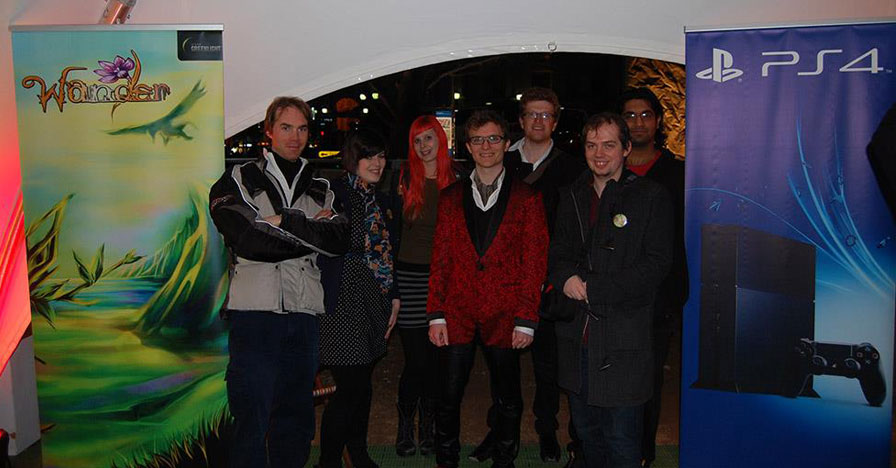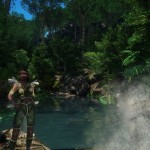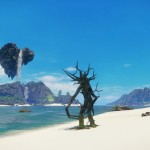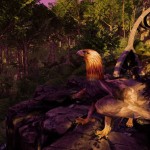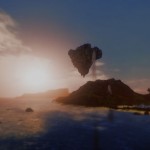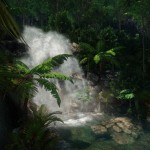Find Wander @ Official website | Facebook | Twitter | Youtube
Thank you for taking time with us to do this interview. Let us begin with the simple questions first. Tell us a little about yourself and how did you get into developing games?
I’m Loki, the creative director on Wander. I was a programmer for a long time and a somewhat of a nomad. I wandered around Central Asia, Siberia, the Arctic and Himalayas. Growing up I played a lot of MUDs (text based MMO games) and wanted to make a game that was atmospheric, relaxing and multiplayer. Wander draws on a lot of that experience. I wanted to collaboratively explore in a game.
Wander looks amazing. Can you tell us more about the game you are developing and where can our readers find information about the game?
Wander is a non-combat MMO game focused on narrative, exploration and joy. You begin as a giant tree and explore a rainforest. As you explore you realise that you are a shape shifter and later realise that everyone is. It’s meant to be relaxing, but also allow player to explore how the form they are in influences how they see the world and interact with others. You can find out more at www.wanderthegame.com
How much planning did you invest into music and sound of the game and how did you find your audio team members?
Music and sound was a key focus for me from the start on Wander. I knew I wanted an authentic, detailed and immersive rainforest soundscape with diegetic music, using live musicans. Ben I met through one of our opera singers and Elaine I met at the Global Game Jam.
One of the descriptions says that opera singers will guide you through your game. What lead to this decision? Was this something that was planned or something your audio team came up with?
I used to be in a band with one of our wonderful opera singers, Seraphim. One of the first parts of the design that we worked out was that the opera singers would act like a sirens song that guides you towards important areas in the game. I love the idea of diegetic music, that makes sense in the world instead of carrying around a magical boom box.
You seem to be using CryEngine for the game. Do you also use the same engine for your audio needs or you are using other middleware like FMOD or Wwise?
CryEngine supports both FMOD and WWise. We are currently using FMOD.
Game audio has been overlooked for years and it’s not considered to be as important as other game development disciplines (art, code, design etc). What are your thoughts about this issue?
Game audio is vital. My favourite games have detailed, emotive soundscapes that are an integral part of the story and atmosphere. I can’t imagine playing any of my favourite games without sound. I think for too long we have used film spatialisation techniques such as 5.1 instead of embracing 3D audio that would work much better for games. We’re very happy to be implementing 3D audio in Wander that allows the player to hear if sounds are above or below them with normal headphones. I’m sure we’re on the cusp of a revolution in game audio. VR will make developers realise its importance and technologies such as TrueAudio and AstoundSound are allowing us to use much more complex techniques in real time.
When is Wander scheduled for the release?
Early 2014 is the plan. Most likely March.
Any tips, hints or motivational speeches for the readers?
Work with people who you think are amazing and that you love working with. Create what you want to create and what makes you happy. If you combine both of these things I think everything else will fall into place. Get lots of advice but realise that sometimes you have to ignore it. I am fantastically lucky to work with Elaine, Ben and the rest of the team. We’re also very lucky to work with the team at GenAudio, especially Greg Morgenstein who mixed and mastered our music.
Could you introduce yourself and how did you started on Wander game?
Ben: I live in the UK and I first got involved in Wander in mid-2013. Prior to joining the Wander team I’d done a good deal of work composing for and working with singers, and Loki initially got me on board to write the songs that function as aural landmarks in the Wander gaming environment. Before too long though, I found myself composing the score for the whole game. The ten-hour time difference between Melbourne and the UK meant that most of my meetings with the Wander team were conducted at pretty eccentric times of day. If the soundtrack comes across as bleary or surreal in places then this might just have something to do with it…
Elaine: I’m a mild audio nerd with chronic dabbling tendencies (especially in games) and a total ignorance of musical theory. My background is mostly in field recording and voice over, with a little circuit bending and chiptunes thrown in. The dabbling has also taken me into music concrete, noise, industrial; anything where a lack of music theory isn’t exactly a prerequisite, but it helps! I joined the Wander team in early 2013 after meeting creative director Loki at the Melbourne chapter of the Global Game Jam.
Elaine, you are the audio lead in the project. Could share with us what are you main tasks as the audio lead?
Elaine: If anything it’s being a facilitator – doing whatever it takes to bring Loki’s vision of Wander to life. Loki is a musician with a background in music programming , so he’s got a very well fleshed-out spec for the audio ‘feel’ of Wander. In practical terms, that mostly translates to audio level design, creating audio assets, working with our fabulous voice actors, and finding the most effective way of incorporating Ben’s amazing work into the game. (Also a little ‘emergency relief’ voice acting in a pinch.)
Could you share with us the process of creating assets for the game? How much planning is involved in a game like this? What is your main approach with the sound design on this project?
Elaine: It depends on the asset, but almost everything has a real recording as the first ingredient. For the footstep surface textures, we collected lots of dirt, twigs, slabs of rock, etc (I still have to return the sand to the beach where it came from – it’s important to maintain biodiversity!), and in the case of the non-humanoids, finding or creating props for their various body parts. My favourite is the Azertash, which involved making shoes out of bathmats.
In terms of process, I’ve learnt the hard way to wait until animations and concept art are available before starting on the audio – it’s easy to get a little keen sometimes! But also to let the ideas ‘cook’ for a bit while waiting for the visuals. Although recording and editing the asset can only take a matter of hours (or even minutes), it can sometimes take weeks to find that perfect piece of junk to make it with.
Wander is mostly taking place in an open environment. How much recordings did your audio team do?
Elaine: How much time have you got? Recording natural ambiances and bird calls has become something of an entrenched habit – it’s an ongoing process that doesn’t really have an end point.
Because we don’t have a traditional looping music track, the forest ambiance accidentally comes to the front of the audio palette. The challenge is getting it to sink back into the background, to recreate the ‘ahhhhh’ moment of being in a rainforest space without analysing its components. And because we want people to play Wander for a long time, we need to damage-control the fact that players will probably hear the same track over and over. So, diversity = good.
But it’s also my favourite audio ‘duty’, getting to go to real rainforests and living the Wander experience. It’s fortunate that Wander is set in a non-existent place ; the coast sounds kind of like Scotland and the forest sounds kind of like Australia and Vietnam!
What obstacles did you or your audio programmer encounter using CryEngine?
Elaine: CryEngine definitely brought with it more advantages than obstacles, although the learning curve continues steeply! Being able to use audio middleware has been a real boon, and so much of the audio behaviour that would normally have to be coded can be controlled using flowgraph, a very visual way of communicating scripting behaviour to the engine. As a non-programmer, it’s a relief to be able to carry out the more basic audio level-design tasks independently.
Because CryEngine automates a lot of the audio stuff already, if you want to do anything custom (which we often do), it takes a lot of sifting to figure out how it’s set up. The animation system is my nemesis, although that’s probably just down to user ignorance.
Challenges for the programmer have also included trying to get the music system to do things it wasn’t designed for, getting the middleware use the 3D audio render (AstoundSound), and well, anything to do with audio and Mannequin. Say no more.
This question is from one of our readers. How did you determine audio levels for your game? Did you subscribe to certain LUFS standards set by Sony or other broadcasting standards… or just go with what felt right?
Elaine: Haha, the second one! Although now I’m going to google ‘LUFS’… There is a loudness testing system for certification on the consoles, so we do follow that. That doesn’t help with deciding how quiet the quiet sections should be, just what max loudness should be.
The move to CryEngine actually really helped with setting levels. The example level that comes packaged with the software has a very developed forest soundscape and foley sounds. We tried to use that as a guide for setting our own levels, along with playing other games through the same speakers and comparing. But we’re still tweaking…
Ben, how did you decide what kind of music you want to create for the game?
Ben: First and foremost, I wanted to create music that really reflected Wander the game. Obviously the beautiful rainforest environment and exploratory gameplay of Wander helped point the music in a certain direction, but more than anything I wanted to create a score that sounded both organic and refreshingly different; something that would help capture the real uniqueness of this game. One of the first decisions we made was to compose the score for an intimate ensemble of live instruments, small enough so as to allow glimpses of the idiosyncrasies and character of each individual instrument shine through. This enabled me to create soundscapes that operated as a multiphony of different voices operated independently and distinctly from one another yet formed a dynamic, evolving whole, creating a musical parallel to the natural sounds of the rainforest. Sound design is a huge part of the Wander experience, so I also wanted to create music that would work in symbiosis with the environmental sound; music that could bloom out of the sound design and then dissolve back into it.
Although the different avatars and locations in Wander each have there own individual characters, I wanted to give the game its own distinctive musical palette. I eventually settled on a 10-piece ensemble comprising a string quartet, three wind instruments, a harp, a five octave marimba and a solo soprano voice. This unusual selection of instruments gave me real flexibility – for instance the marimba could function as both a percussive melody instrument and as an almost organ-like pad, and the soprano could either sail out above the texture or blend in seamlessly with the woodwind choir. From this palette I created character-focused pieces for each of the avatars in Wander, deriving some pieces of musical material from these avatars’ songs I’d composed earlier. We wanted to steer clear of animal and mythological stereotypes and to give these avatars fresh identities. As such, we chose to infuse the Azertash’s murky underwater environment with a sense of fun and adventure and to give the Griffon an aura of peaceful grace.
Restricting ourselves to this small, live ensemble enabled me to exploit some of the nuances that only real live musicians can create and to write some really delicate music for Wander. Since we recorded most of the music with the musicians all playing together in the same room at the same time, we could also abandon the click track for the most part and let the ensemble really breathe some life into the performance.
What was the process like and what software/hardware did you use to make the game music?
Ben: Every single musical sound in Wander was recorded live – there are no samples, no midi, no synths: just real, live musicians, recorded at the Belle Shenkman Studio in London. All the standalone cues were recorded with the ensemble playing together in the same room; the generative music (for the cave and dreamweaving environments) was recorded in layers. We mic’d some of the instruments really close to give the recordings a real sense of air and breath. We used four mics on the marimba: two to capture the woody attack of the rosewood keys, and two to capture the breathy resonance of the metal resonators. The tracks were all recorded and mixed in ProTools, and then many of the cues were sent off to the US where the team at GenAudio turned them into some incredible binaural mixes using their AstoundSound technology. This gives the impression – even when listening in stereo – that the player is surrounded by the music and further helps blend the musical sounds with those of the forest.
How much planning did you do before you actually started writing the game music?
Ben: Writing the music came right at the end of the process – I try and get absolutely everything else in place before I start putting notes onto paper. In fact, I tried to avoid thinking in terms of music until I’d got a really strong feel for the concept, preferring first to form a creative template of adjectives, stories and ideas. That way I could ensure that the music would come from within Wander, and not just be a load of musical ideas I’d slapped on top of the visuals. Working with these adjectives, stories and ideas was particularly important for this project since the live-recorded instrumentals meant there would be very little scope for drafts, changes and alterations – I had to be sure that I was on exactly the same page as the rest of the creative team before I let loose with the score. Once we’d worked hard to establish all the conceptual criteria – mood, tone, character, storytelling, pace, musical palette, duration etc – the music almost wrote itself.
Any tips, hints or motivational speeches for the readers?
Ben: Wander was the first game I scored, so I don’t think I’m in a position to offer much in the way of help and advice! I am very grateful to all those who gave me hints and tips (not to mention the motivational speeches) while I was working on Wander – Elaine & Loki, the ten brilliant musicians, Bea & Ed in the control room, the team at GenAudio and veteran games composers Garry Schyman and Helge Borgarts who kindly offered their help and advice.
Elaine: Echoing Ben, appreciating and learning from great people. The game dev community is extremely supportive and there’s a wealth of wonderful, giving geniuses out there who share their experiences and advice with great generosity (FMOD, Astound Sound, Sound Librarian). It’s been wonderful working with Rebecca, Kathryn, Meaghan and Gaelle our voice actors.


